Case Study: Nursing and Interprofessional Management of Ischaemic CVA
VerifiedAdded on 2022/10/10
|8
|2119
|333
Case Study
AI Summary
This case study examines the nursing and interprofessional care of a 74-year-old man, Mr. Sam Kwon, who presented with right-sided hemiparalysis, aphasia, and facial drooping following an ischaemic CVA. The paper begins by outlining the incidence and prevalence of ischaemic CVA in Australia and compares it to another country, highlighting the significant health burden and risk factors involved. The study then delves into Mr. Kwon's case, critically discussing the neurological, sensory, and motor assessment findings, considering his medical history of hypertension, congestive heart failure, and type 2 diabetes. The core of the paper focuses on the nursing and interprofessional care and management strategies for Mr. Kwon, including physiotherapy, occupational therapy, speech therapy, and the importance of a supportive environment to improve his recovery. The discussion is supported by current evidence-based literature, emphasizing the need for tailored interventions and collaborative approaches to improve patient outcomes. The conclusion summarizes the assessment findings and underscores the importance of proactive nursing interventions and interprofessional care for effective CVA management.

Running head: Nursing and inter professional care
Nursing and inter professional care
Name of the student:
Name of the university:
Authors note:
Nursing and inter professional care
Name of the student:
Name of the university:
Authors note:
Paraphrase This Document
Need a fresh take? Get an instant paraphrase of this document with our AI Paraphraser
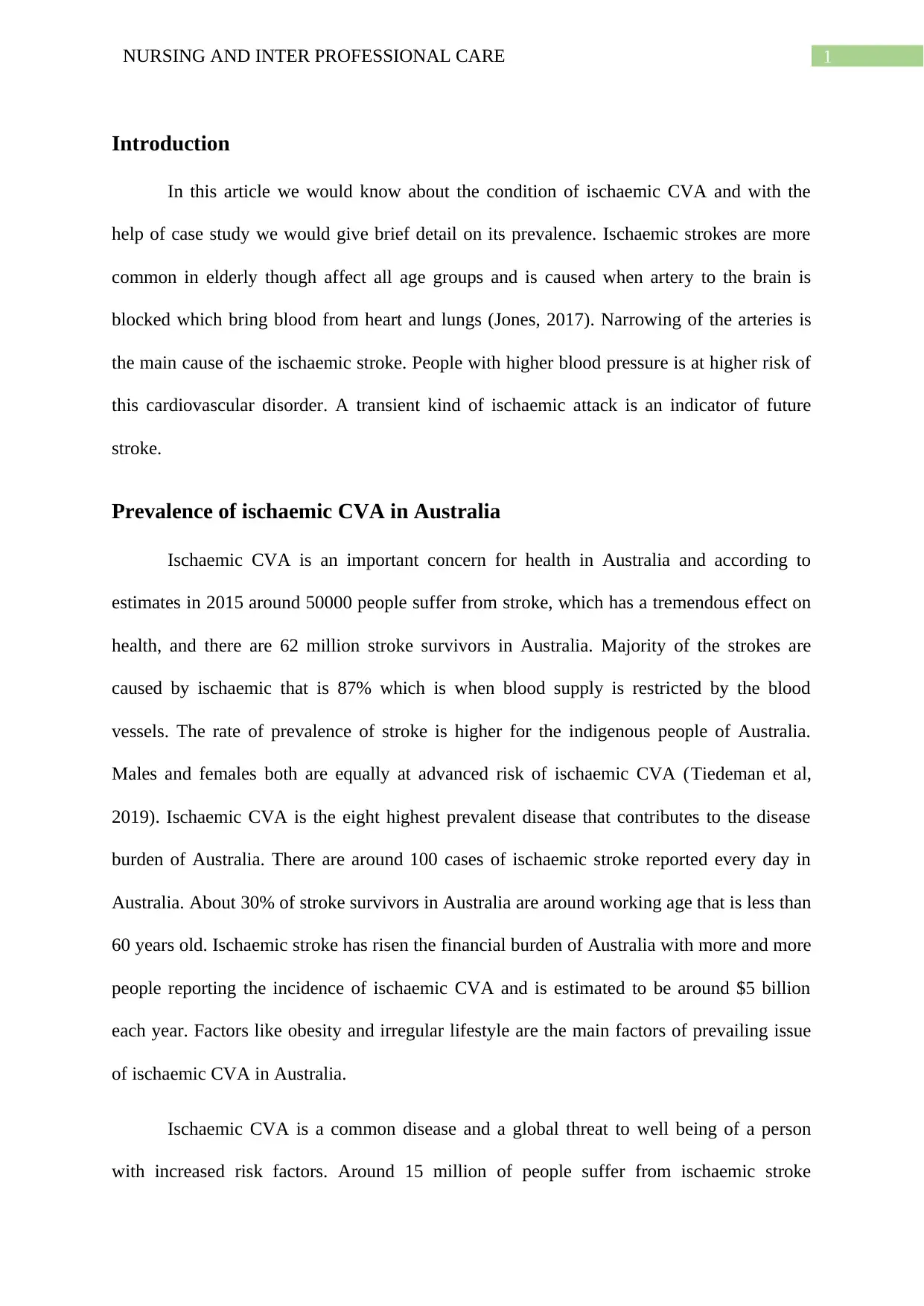
1NURSING AND INTER PROFESSIONAL CARE
Introduction
In this article we would know about the condition of ischaemic CVA and with the
help of case study we would give brief detail on its prevalence. Ischaemic strokes are more
common in elderly though affect all age groups and is caused when artery to the brain is
blocked which bring blood from heart and lungs (Jones, 2017). Narrowing of the arteries is
the main cause of the ischaemic stroke. People with higher blood pressure is at higher risk of
this cardiovascular disorder. A transient kind of ischaemic attack is an indicator of future
stroke.
Prevalence of ischaemic CVA in Australia
Ischaemic CVA is an important concern for health in Australia and according to
estimates in 2015 around 50000 people suffer from stroke, which has a tremendous effect on
health, and there are 62 million stroke survivors in Australia. Majority of the strokes are
caused by ischaemic that is 87% which is when blood supply is restricted by the blood
vessels. The rate of prevalence of stroke is higher for the indigenous people of Australia.
Males and females both are equally at advanced risk of ischaemic CVA (Tiedeman et al,
2019). Ischaemic CVA is the eight highest prevalent disease that contributes to the disease
burden of Australia. There are around 100 cases of ischaemic stroke reported every day in
Australia. About 30% of stroke survivors in Australia are around working age that is less than
60 years old. Ischaemic stroke has risen the financial burden of Australia with more and more
people reporting the incidence of ischaemic CVA and is estimated to be around $5 billion
each year. Factors like obesity and irregular lifestyle are the main factors of prevailing issue
of ischaemic CVA in Australia.
Ischaemic CVA is a common disease and a global threat to well being of a person
with increased risk factors. Around 15 million of people suffer from ischaemic stroke
Introduction
In this article we would know about the condition of ischaemic CVA and with the
help of case study we would give brief detail on its prevalence. Ischaemic strokes are more
common in elderly though affect all age groups and is caused when artery to the brain is
blocked which bring blood from heart and lungs (Jones, 2017). Narrowing of the arteries is
the main cause of the ischaemic stroke. People with higher blood pressure is at higher risk of
this cardiovascular disorder. A transient kind of ischaemic attack is an indicator of future
stroke.
Prevalence of ischaemic CVA in Australia
Ischaemic CVA is an important concern for health in Australia and according to
estimates in 2015 around 50000 people suffer from stroke, which has a tremendous effect on
health, and there are 62 million stroke survivors in Australia. Majority of the strokes are
caused by ischaemic that is 87% which is when blood supply is restricted by the blood
vessels. The rate of prevalence of stroke is higher for the indigenous people of Australia.
Males and females both are equally at advanced risk of ischaemic CVA (Tiedeman et al,
2019). Ischaemic CVA is the eight highest prevalent disease that contributes to the disease
burden of Australia. There are around 100 cases of ischaemic stroke reported every day in
Australia. About 30% of stroke survivors in Australia are around working age that is less than
60 years old. Ischaemic stroke has risen the financial burden of Australia with more and more
people reporting the incidence of ischaemic CVA and is estimated to be around $5 billion
each year. Factors like obesity and irregular lifestyle are the main factors of prevailing issue
of ischaemic CVA in Australia.
Ischaemic CVA is a common disease and a global threat to well being of a person
with increased risk factors. Around 15 million of people suffer from ischaemic stroke
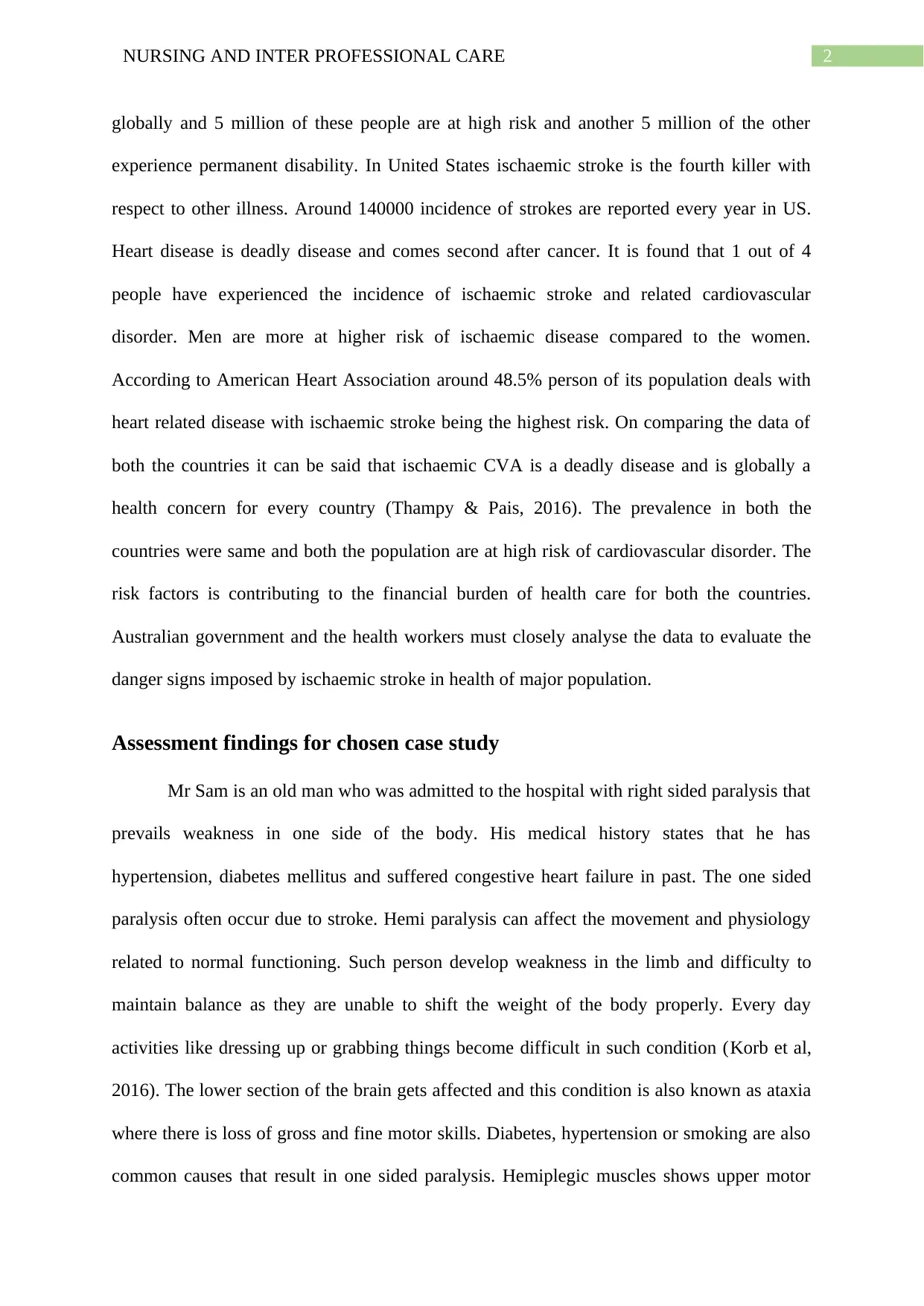
2NURSING AND INTER PROFESSIONAL CARE
globally and 5 million of these people are at high risk and another 5 million of the other
experience permanent disability. In United States ischaemic stroke is the fourth killer with
respect to other illness. Around 140000 incidence of strokes are reported every year in US.
Heart disease is deadly disease and comes second after cancer. It is found that 1 out of 4
people have experienced the incidence of ischaemic stroke and related cardiovascular
disorder. Men are more at higher risk of ischaemic disease compared to the women.
According to American Heart Association around 48.5% person of its population deals with
heart related disease with ischaemic stroke being the highest risk. On comparing the data of
both the countries it can be said that ischaemic CVA is a deadly disease and is globally a
health concern for every country (Thampy & Pais, 2016). The prevalence in both the
countries were same and both the population are at high risk of cardiovascular disorder. The
risk factors is contributing to the financial burden of health care for both the countries.
Australian government and the health workers must closely analyse the data to evaluate the
danger signs imposed by ischaemic stroke in health of major population.
Assessment findings for chosen case study
Mr Sam is an old man who was admitted to the hospital with right sided paralysis that
prevails weakness in one side of the body. His medical history states that he has
hypertension, diabetes mellitus and suffered congestive heart failure in past. The one sided
paralysis often occur due to stroke. Hemi paralysis can affect the movement and physiology
related to normal functioning. Such person develop weakness in the limb and difficulty to
maintain balance as they are unable to shift the weight of the body properly. Every day
activities like dressing up or grabbing things become difficult in such condition (Korb et al,
2016). The lower section of the brain gets affected and this condition is also known as ataxia
where there is loss of gross and fine motor skills. Diabetes, hypertension or smoking are also
common causes that result in one sided paralysis. Hemiplegic muscles shows upper motor
globally and 5 million of these people are at high risk and another 5 million of the other
experience permanent disability. In United States ischaemic stroke is the fourth killer with
respect to other illness. Around 140000 incidence of strokes are reported every year in US.
Heart disease is deadly disease and comes second after cancer. It is found that 1 out of 4
people have experienced the incidence of ischaemic stroke and related cardiovascular
disorder. Men are more at higher risk of ischaemic disease compared to the women.
According to American Heart Association around 48.5% person of its population deals with
heart related disease with ischaemic stroke being the highest risk. On comparing the data of
both the countries it can be said that ischaemic CVA is a deadly disease and is globally a
health concern for every country (Thampy & Pais, 2016). The prevalence in both the
countries were same and both the population are at high risk of cardiovascular disorder. The
risk factors is contributing to the financial burden of health care for both the countries.
Australian government and the health workers must closely analyse the data to evaluate the
danger signs imposed by ischaemic stroke in health of major population.
Assessment findings for chosen case study
Mr Sam is an old man who was admitted to the hospital with right sided paralysis that
prevails weakness in one side of the body. His medical history states that he has
hypertension, diabetes mellitus and suffered congestive heart failure in past. The one sided
paralysis often occur due to stroke. Hemi paralysis can affect the movement and physiology
related to normal functioning. Such person develop weakness in the limb and difficulty to
maintain balance as they are unable to shift the weight of the body properly. Every day
activities like dressing up or grabbing things become difficult in such condition (Korb et al,
2016). The lower section of the brain gets affected and this condition is also known as ataxia
where there is loss of gross and fine motor skills. Diabetes, hypertension or smoking are also
common causes that result in one sided paralysis. Hemiplegic muscles shows upper motor
⊘ This is a preview!⊘
Do you want full access?
Subscribe today to unlock all pages.

Trusted by 1+ million students worldwide
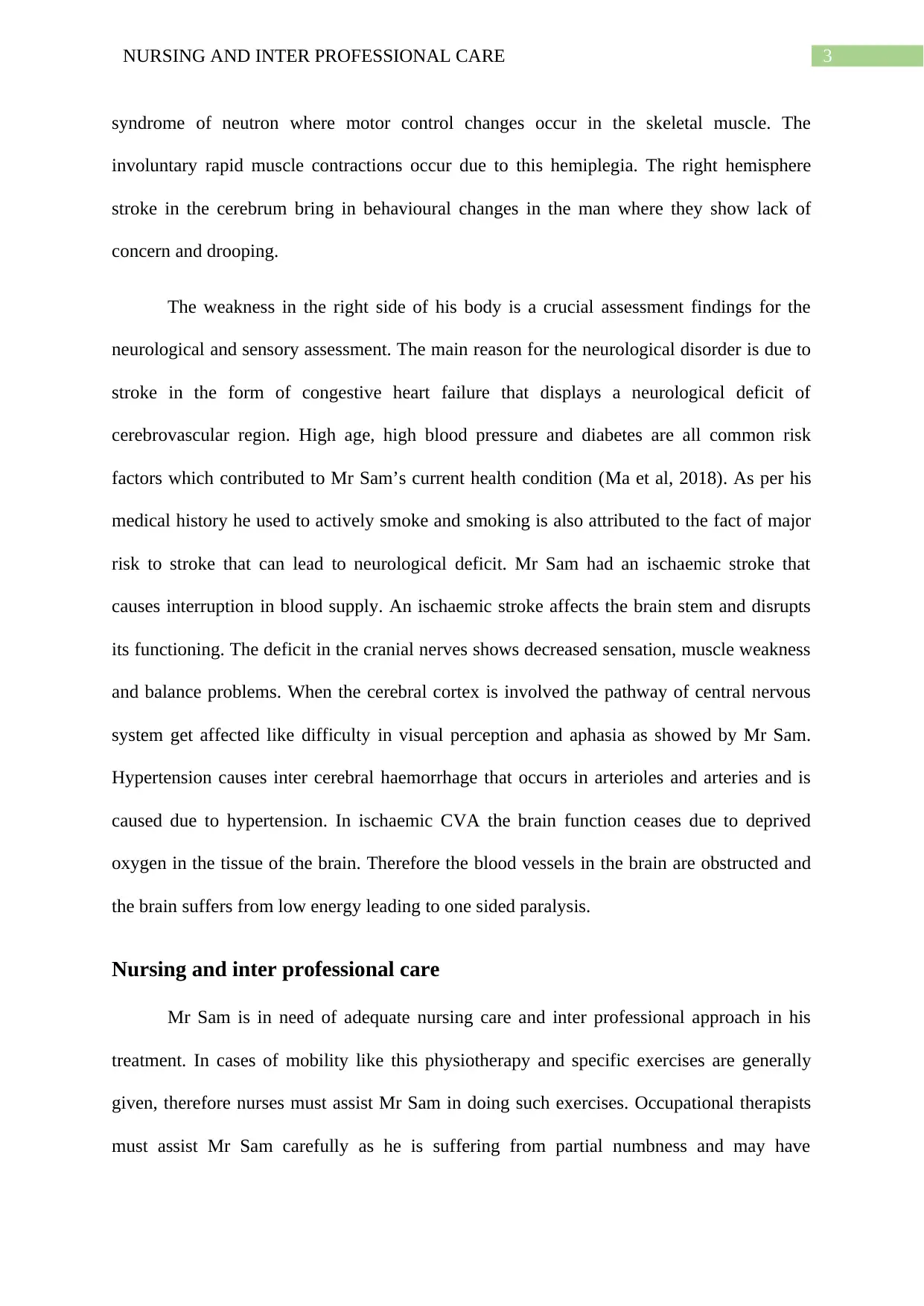
3NURSING AND INTER PROFESSIONAL CARE
syndrome of neutron where motor control changes occur in the skeletal muscle. The
involuntary rapid muscle contractions occur due to this hemiplegia. The right hemisphere
stroke in the cerebrum bring in behavioural changes in the man where they show lack of
concern and drooping.
The weakness in the right side of his body is a crucial assessment findings for the
neurological and sensory assessment. The main reason for the neurological disorder is due to
stroke in the form of congestive heart failure that displays a neurological deficit of
cerebrovascular region. High age, high blood pressure and diabetes are all common risk
factors which contributed to Mr Sam’s current health condition (Ma et al, 2018). As per his
medical history he used to actively smoke and smoking is also attributed to the fact of major
risk to stroke that can lead to neurological deficit. Mr Sam had an ischaemic stroke that
causes interruption in blood supply. An ischaemic stroke affects the brain stem and disrupts
its functioning. The deficit in the cranial nerves shows decreased sensation, muscle weakness
and balance problems. When the cerebral cortex is involved the pathway of central nervous
system get affected like difficulty in visual perception and aphasia as showed by Mr Sam.
Hypertension causes inter cerebral haemorrhage that occurs in arterioles and arteries and is
caused due to hypertension. In ischaemic CVA the brain function ceases due to deprived
oxygen in the tissue of the brain. Therefore the blood vessels in the brain are obstructed and
the brain suffers from low energy leading to one sided paralysis.
Nursing and inter professional care
Mr Sam is in need of adequate nursing care and inter professional approach in his
treatment. In cases of mobility like this physiotherapy and specific exercises are generally
given, therefore nurses must assist Mr Sam in doing such exercises. Occupational therapists
must assist Mr Sam carefully as he is suffering from partial numbness and may have
syndrome of neutron where motor control changes occur in the skeletal muscle. The
involuntary rapid muscle contractions occur due to this hemiplegia. The right hemisphere
stroke in the cerebrum bring in behavioural changes in the man where they show lack of
concern and drooping.
The weakness in the right side of his body is a crucial assessment findings for the
neurological and sensory assessment. The main reason for the neurological disorder is due to
stroke in the form of congestive heart failure that displays a neurological deficit of
cerebrovascular region. High age, high blood pressure and diabetes are all common risk
factors which contributed to Mr Sam’s current health condition (Ma et al, 2018). As per his
medical history he used to actively smoke and smoking is also attributed to the fact of major
risk to stroke that can lead to neurological deficit. Mr Sam had an ischaemic stroke that
causes interruption in blood supply. An ischaemic stroke affects the brain stem and disrupts
its functioning. The deficit in the cranial nerves shows decreased sensation, muscle weakness
and balance problems. When the cerebral cortex is involved the pathway of central nervous
system get affected like difficulty in visual perception and aphasia as showed by Mr Sam.
Hypertension causes inter cerebral haemorrhage that occurs in arterioles and arteries and is
caused due to hypertension. In ischaemic CVA the brain function ceases due to deprived
oxygen in the tissue of the brain. Therefore the blood vessels in the brain are obstructed and
the brain suffers from low energy leading to one sided paralysis.
Nursing and inter professional care
Mr Sam is in need of adequate nursing care and inter professional approach in his
treatment. In cases of mobility like this physiotherapy and specific exercises are generally
given, therefore nurses must assist Mr Sam in doing such exercises. Occupational therapists
must assist Mr Sam carefully as he is suffering from partial numbness and may have
Paraphrase This Document
Need a fresh take? Get an instant paraphrase of this document with our AI Paraphraser

4NURSING AND INTER PROFESSIONAL CARE
difficulty in doing such exercises. Mr Sam must be admitted in separate ward where there is
special provision given for such nurses (Nielsen et al, 2015). The physiotherapist must
include common points in their treatment plan like stimulation of upper limb, maintaining the
anti synergistic properties and maintenance of muscle strength. Assisting technologies may
also be used if needed like wheel chairs or canes that may be beneficial in the treatment. The
physiotherapist must focus on simple exercises like walking a small distance or transferring
objects from one place to another. This way everyday this kind of exercises must be followed
with instructor always present. There must be close evaluation of the outcome of such
exercises on Mr Sam. Constraint induced movement therapy is a common therapy provided
to the patients for posture development and can be utilised on Mr Sam.
Mr Sam must be encouraged by the nurses to try to utilise his right leg more and
evaluate the movement by himself. Nurses must have close look on his physiotherapy
treatments and see how Mr Sam is progressing. The nurses must ensure that the treatment
interventions are based on the special side that is on his right limb and create suitable short
term goals. The nurses must also check other physiological parameters of Mr Sam like blood
pressure and diabetes to cut the risk of future stroke which has direct relation to the
neuromuscular disability (Pistoia et al, 2016). Mr Sam is also suffering from facial drooping
therefore facial exercises must also be given to him. In this condition it is important to keep
the patient encouraged otherwise the therapy may not be fulfilled. The nurses must positively
influence the patient by saying that he will recover soon and would lead a daily life. Such
positive words have a good influence on patient. It must be made sure that Mr Sam is not
pressurised in doing such exercises. Small walks can be beneficial for Mr Sam in his
treatment. Speech and language therapy must also be provided with occupational therapy and
help Mr Sam in his speech disability (Stein, 2018). Therefore with proper nursing care from
difficulty in doing such exercises. Mr Sam must be admitted in separate ward where there is
special provision given for such nurses (Nielsen et al, 2015). The physiotherapist must
include common points in their treatment plan like stimulation of upper limb, maintaining the
anti synergistic properties and maintenance of muscle strength. Assisting technologies may
also be used if needed like wheel chairs or canes that may be beneficial in the treatment. The
physiotherapist must focus on simple exercises like walking a small distance or transferring
objects from one place to another. This way everyday this kind of exercises must be followed
with instructor always present. There must be close evaluation of the outcome of such
exercises on Mr Sam. Constraint induced movement therapy is a common therapy provided
to the patients for posture development and can be utilised on Mr Sam.
Mr Sam must be encouraged by the nurses to try to utilise his right leg more and
evaluate the movement by himself. Nurses must have close look on his physiotherapy
treatments and see how Mr Sam is progressing. The nurses must ensure that the treatment
interventions are based on the special side that is on his right limb and create suitable short
term goals. The nurses must also check other physiological parameters of Mr Sam like blood
pressure and diabetes to cut the risk of future stroke which has direct relation to the
neuromuscular disability (Pistoia et al, 2016). Mr Sam is also suffering from facial drooping
therefore facial exercises must also be given to him. In this condition it is important to keep
the patient encouraged otherwise the therapy may not be fulfilled. The nurses must positively
influence the patient by saying that he will recover soon and would lead a daily life. Such
positive words have a good influence on patient. It must be made sure that Mr Sam is not
pressurised in doing such exercises. Small walks can be beneficial for Mr Sam in his
treatment. Speech and language therapy must also be provided with occupational therapy and
help Mr Sam in his speech disability (Stein, 2018). Therefore with proper nursing care from
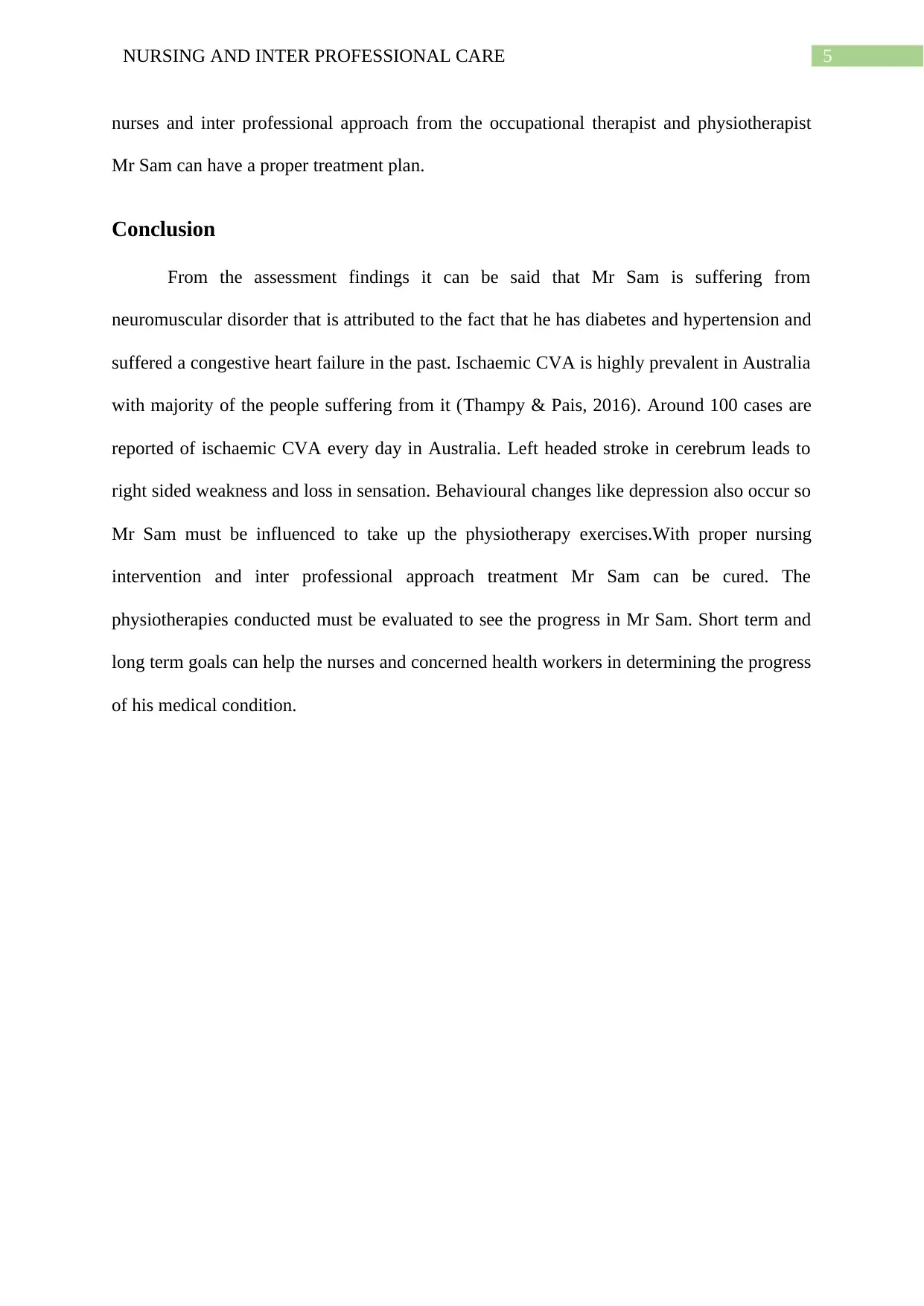
5NURSING AND INTER PROFESSIONAL CARE
nurses and inter professional approach from the occupational therapist and physiotherapist
Mr Sam can have a proper treatment plan.
Conclusion
From the assessment findings it can be said that Mr Sam is suffering from
neuromuscular disorder that is attributed to the fact that he has diabetes and hypertension and
suffered a congestive heart failure in the past. Ischaemic CVA is highly prevalent in Australia
with majority of the people suffering from it (Thampy & Pais, 2016). Around 100 cases are
reported of ischaemic CVA every day in Australia. Left headed stroke in cerebrum leads to
right sided weakness and loss in sensation. Behavioural changes like depression also occur so
Mr Sam must be influenced to take up the physiotherapy exercises.With proper nursing
intervention and inter professional approach treatment Mr Sam can be cured. The
physiotherapies conducted must be evaluated to see the progress in Mr Sam. Short term and
long term goals can help the nurses and concerned health workers in determining the progress
of his medical condition.
nurses and inter professional approach from the occupational therapist and physiotherapist
Mr Sam can have a proper treatment plan.
Conclusion
From the assessment findings it can be said that Mr Sam is suffering from
neuromuscular disorder that is attributed to the fact that he has diabetes and hypertension and
suffered a congestive heart failure in the past. Ischaemic CVA is highly prevalent in Australia
with majority of the people suffering from it (Thampy & Pais, 2016). Around 100 cases are
reported of ischaemic CVA every day in Australia. Left headed stroke in cerebrum leads to
right sided weakness and loss in sensation. Behavioural changes like depression also occur so
Mr Sam must be influenced to take up the physiotherapy exercises.With proper nursing
intervention and inter professional approach treatment Mr Sam can be cured. The
physiotherapies conducted must be evaluated to see the progress in Mr Sam. Short term and
long term goals can help the nurses and concerned health workers in determining the progress
of his medical condition.
⊘ This is a preview!⊘
Do you want full access?
Subscribe today to unlock all pages.

Trusted by 1+ million students worldwide

6NURSING AND INTER PROFESSIONAL CARE
References
Jones, T. A. (2017). Motor compensation and its effects on neural reorganization after
stroke. Nature Reviews Neuroscience, 18(5), 267.
Korb, S., Wood, A., Banks, C. A., Agoulnik, D., Hadlock, T. A., & Niedenthal, P. M. (2016).
Asymmetry of facial mimicry and emotion perception in patients with unilateral facial
paralysis. JAMA facial plastic surgery, 18(3), 222-227.
Ma, W., Cheng, H., Huang, R., & Chen, Q. (2018, December). Gait Planning with Dynamic
Movement Primitives for Lower Limb Exoskeleton Walking Up Stairs. In 2018 IEEE
International Conference on Robotics and Biomimetics (ROBIO) (pp. 703-708).
IEEE.
Nielsen, G., Stone, J., Matthews, A., Brown, M., Sparkes, C., Farmer, R., ... & Lumsden, C.
(2015). Physiotherapy for functional motor disorders: a consensus recommendation. J
Neurol Neurosurg Psychiatry, 86(10), 1113-1119.
Pistoia, F., Sacco, S., Degan, D., Tiseo, C., Ornello, R., & Carolei, A. (2016). Hypertension
and stroke: epidemiological aspects and clinical evaluation. High Blood Pressure &
Cardiovascular Prevention, 23(1), 9-18.
Stein, L. (2018). Speech and voice: their evolution, pathology and therapy. Routledge.
Stone, J., & Aybek, S. (2016). Functional limb weakness and paralysis. In Handbook of
clinical neurology (Vol. 139, pp. 213-228). Elsevier.
Thampy, A., & Pais, C. C. (2016). Early clinical implications of microalbuminuria in patients
with acute ischaemic stroke. Journal of clinical and diagnostic research:
JCDR, 10(9), OC29.
References
Jones, T. A. (2017). Motor compensation and its effects on neural reorganization after
stroke. Nature Reviews Neuroscience, 18(5), 267.
Korb, S., Wood, A., Banks, C. A., Agoulnik, D., Hadlock, T. A., & Niedenthal, P. M. (2016).
Asymmetry of facial mimicry and emotion perception in patients with unilateral facial
paralysis. JAMA facial plastic surgery, 18(3), 222-227.
Ma, W., Cheng, H., Huang, R., & Chen, Q. (2018, December). Gait Planning with Dynamic
Movement Primitives for Lower Limb Exoskeleton Walking Up Stairs. In 2018 IEEE
International Conference on Robotics and Biomimetics (ROBIO) (pp. 703-708).
IEEE.
Nielsen, G., Stone, J., Matthews, A., Brown, M., Sparkes, C., Farmer, R., ... & Lumsden, C.
(2015). Physiotherapy for functional motor disorders: a consensus recommendation. J
Neurol Neurosurg Psychiatry, 86(10), 1113-1119.
Pistoia, F., Sacco, S., Degan, D., Tiseo, C., Ornello, R., & Carolei, A. (2016). Hypertension
and stroke: epidemiological aspects and clinical evaluation. High Blood Pressure &
Cardiovascular Prevention, 23(1), 9-18.
Stein, L. (2018). Speech and voice: their evolution, pathology and therapy. Routledge.
Stone, J., & Aybek, S. (2016). Functional limb weakness and paralysis. In Handbook of
clinical neurology (Vol. 139, pp. 213-228). Elsevier.
Thampy, A., & Pais, C. C. (2016). Early clinical implications of microalbuminuria in patients
with acute ischaemic stroke. Journal of clinical and diagnostic research:
JCDR, 10(9), OC29.
Paraphrase This Document
Need a fresh take? Get an instant paraphrase of this document with our AI Paraphraser
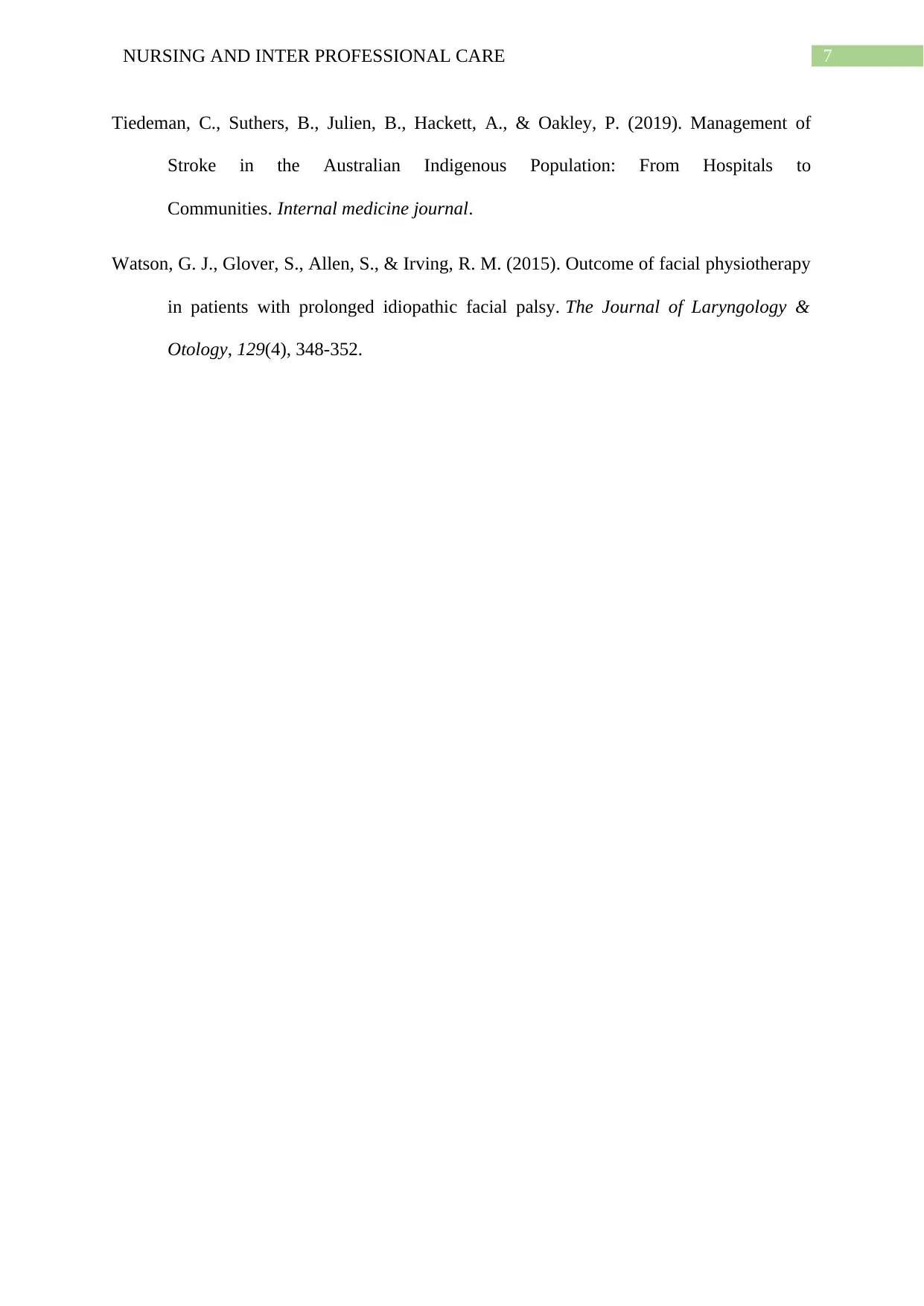
7NURSING AND INTER PROFESSIONAL CARE
Tiedeman, C., Suthers, B., Julien, B., Hackett, A., & Oakley, P. (2019). Management of
Stroke in the Australian Indigenous Population: From Hospitals to
Communities. Internal medicine journal.
Watson, G. J., Glover, S., Allen, S., & Irving, R. M. (2015). Outcome of facial physiotherapy
in patients with prolonged idiopathic facial palsy. The Journal of Laryngology &
Otology, 129(4), 348-352.
Tiedeman, C., Suthers, B., Julien, B., Hackett, A., & Oakley, P. (2019). Management of
Stroke in the Australian Indigenous Population: From Hospitals to
Communities. Internal medicine journal.
Watson, G. J., Glover, S., Allen, S., & Irving, R. M. (2015). Outcome of facial physiotherapy
in patients with prolonged idiopathic facial palsy. The Journal of Laryngology &
Otology, 129(4), 348-352.
1 out of 8
Related Documents
Your All-in-One AI-Powered Toolkit for Academic Success.
+13062052269
info@desklib.com
Available 24*7 on WhatsApp / Email
![[object Object]](/_next/static/media/star-bottom.7253800d.svg)
Unlock your academic potential
Copyright © 2020–2025 A2Z Services. All Rights Reserved. Developed and managed by ZUCOL.





